UPSC Exam > UPSC Notes > History for UPSC CSE > The Mughal Empire (1526-40) and (1555-1857)
The Mughal Empire (1526-40) and (1555-1857) | History for UPSC CSE PDF Download
Introduction
- The Mughal emperors were descendants of two prominent Central Asian and Mongolian ruling families.
- Babur: the founder of the Mughal Empire in India was related to Timur from his father’s side and to Genghis Khan through his mother.
- Babur succeeded his father as the ruler of Fergana (Uzbekistan) but soon lost his kingdom.
- Babur was facing financial difficulties, concerns about a potential Uzbek invasion of Kabul, and an invitation from Rana Sanga to invade India, which prompted his shift of focus towards India.
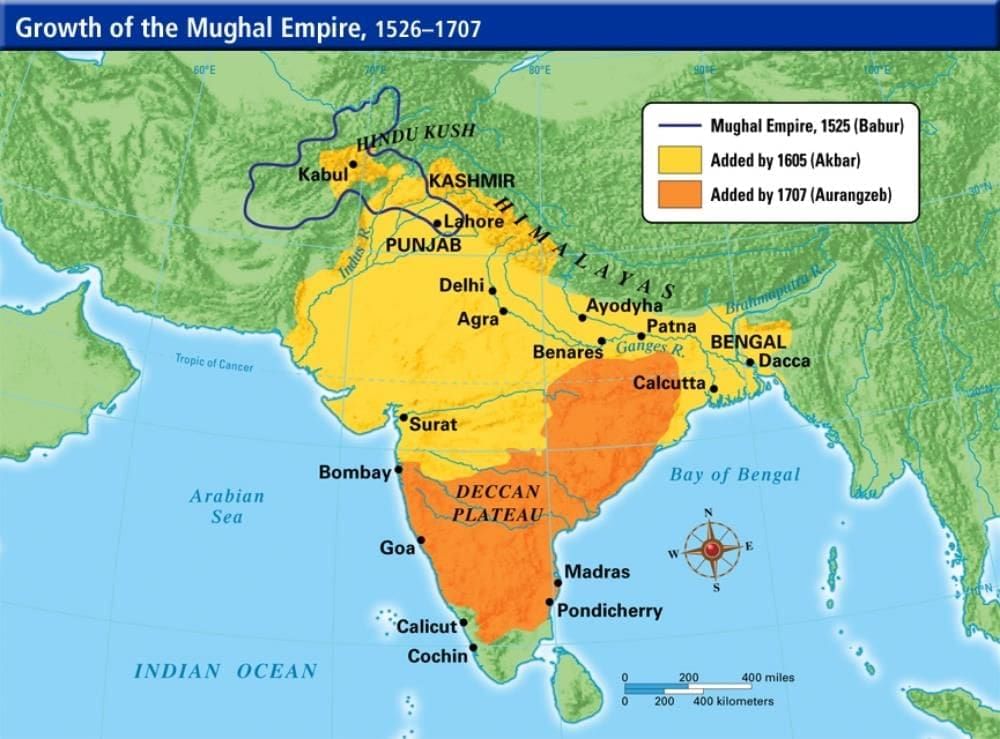 Growth of Mughal Empire
Growth of Mughal Empire
Babur (1526 - 1530 AD)
 Babur
Babur
- Defeated Ibrahim Lodi at Panipat in 1526.
- Was a descendant of Timur on his father's side and of Genghis Khan on his mother's side.
- Umar Shaikh Mirza was his father .
- After defeating Ibrahim Lodi, he won a decisive victory against the Afghans.
- Defeated the Rana of Mewar, Sangram Singh or Rana Sanga on March 16, 1527, at Khanua.
- In 1528, he captured Chanderi from Rajput chief Medini Rai. A year later, he defeated the Afghan chiefs under Mahmud Lodi in the Battle of Ghagra in Bihar.
- A detailed record of Babur's career is found in his autobiography —Tuzuk-i-Baburi or Baburnamah—which he wrote in his mother tongue (Turki).
Significance of Babur's Advent into India
- Babur created Char-Bagh and designed gardens.
- Mosques were constructed by Babur in Panipat and Sambhal in Rohilkhand.
- Notable literary contributions include the Tuzuk-i-Baburi (Babarnama) and Masnavi by Babur.
- Kabul and Gandhara were incorporated as integral parts of the expanding Mughal Empire.
- Babur laid the foundation of the Mughal Empire in India, which later provided the dynasty nearly two centuries of protection from external invasions.
- Babur played a key role in popularising the use of gunpowder, cavalry, and artillery in India, even though gunpowder had been used earlier in the region.
- Babur contributed to the strengthening of India's foreign trade.
- Introducing a new mode of warfare, Babur significantly influenced military strategies in India.
- By defeating Sanga and Lodi, Babur disrupted the balance of power and laid the foundation for a unified empire in India.
- Babur assumed the title of Padshah during his reign.
Question for The Mughal Empire (1526-40) and (1555-1857)Try yourself: What significant contribution did Babur make to the Mughal Empire?View Solution
Humayun (1530-40 & 1555-56)
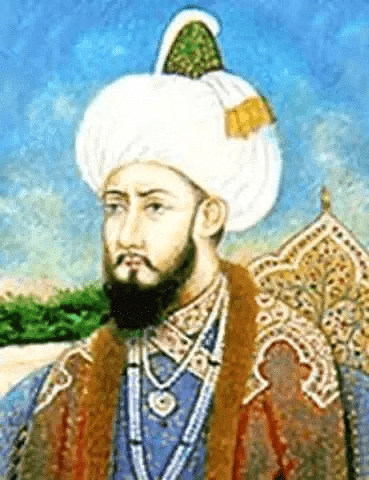 Humayun
Humayun
- Humayun became the emperor in Agra on December 29, 1530 CE.
- He divided large parts of his father's empire among his three brothers and two cousins.
- Kamran Mirza, Humayun’s brother, was confirmed in his possession of Kabul and Kandahar.
- Askari got Sambhal, while Hindal was given Alwar and Mewat.
- His first important military action was taking Kalinjar, which was vital for his control over northern India.
- In 1532 CE, he defeated the Afghans at the Battle of Dauhria.
- Sher Shah proved to be the most formidable enemy of Humayun, and after defeating the latter at Chausa and Kanauj in 1540, completely shattered his prospects.
- After his final defeat at the hands of Sher Shah Suri the Mughal empire in India was temporarily eclipsed and Humayun had to pass nearly fifteen years (1540-55) in exile.
- After regaining his empire, Humayun died in an accident shortly after.
Sher Shah Suri (1540-1545)

- Founder and Duration: Sher Shah Suri was the founder of the Suri dynasty, which succeeded the Lodhi dynasty in India. His reign lasted for five years, from 1540 to 1545.
- Administrative Achievements:
- Notable constructions during his reign included the Purana Qila (Old Fort) and its mosque, as well as the Mausoleum at Sasaram.
- Malik Muhammad Jayasi authored the renowned Hindi work "Padmavat" during Sher Shah's rule.
- Continuity in Central Administration: Sher Shah retained the central administration structure of the earlier Sultanate period. Key officials included:
- Diwan-i-Wizarat/Wazir: Responsible for revenue and finance.
- Diwan-i-Ariz: In charge of the army.
- Diwan-i-Rasalat: Foreign minister.
- Diwan-i-Insha: Responsible for communications.
- Barid: In charge of intelligence.
- Empire Division and Local Administration:
- Sher Shah divided his empire into administrative units called "sarkars."
- Each sarkar had a Chief Shiqdar (law and order) and Chief Munsif (judge) overseeing administration.
- Each sarkar was further divided into Parganas, each administered by Shiqdar, Amin, Fotedar, and Karkuns.
- Mauza (village) constituted the lowest level of administration.
- Administrative Units and Officers:
- Administrative units called iqtas were also present.
- Revenue officers, known as Amils, and Qanungo maintained revenue records.
- Land Revenue System:
- Sher Shah implemented a detailed land revenue system, which included a survey of land and a schedule of crop rates (rai).
- Improved land revenue through zabti-i-har-sal (annual land assessment).
- Cultivable land was classified into three categories: good, middle, and bad. The state’s share of the produce was one-third, paid in cash or crops.
- New practices such as Patta (peasant payment) and Qabuliyat (deed of agreement) were introduced.
- Currency:
- Sher Shah introduced new copper coins called "Dam," which were used in various forms across different regions until after 1835.
- Trade Routes:
- Sher Shah established the Shahi Road, later known as the Grand Trunk (GT) Road, which connected Calcutta and Peshawar.
- This road was equipped with Sarais (lodging places) that served as post offices and eventually developed into market towns.
- Military and Administrative Practices:
- Sher Shah adopted horse branding practices from Alauddin Khalji.
- Maintained a personal royal force known as Khasa Kail.
Question for The Mughal Empire (1526-40) and (1555-1857)Try yourself:Who was the most formidable enemy of Humayun?
View Solution
Akbar (1556-1605)
 Akbar
Akbar
- Akbar was coronated at Kalanaur.
- Within months of Akbar’s accession, Hemu, the wazir of Muhammad Adil Shah, occupied the region from Bayana to Delhi, including Agra, and assumed the title of Vikramaditya.
- In November 1556, the Mughal army under Bairam Khan moved towards Delhi and defeated and killed Hemu in the second battle of Panipat.
- During the years 1556-60, Bairam Khan enjoyed the supreme position in the state as the emperor’s guardian and Prime Minister.
- The concentration of power in his hands, his arrogance and arbitrary methods led to the fall of Bairam Khan in 1560.
Conquests
- Malwa was taken from Baz Bahadur in 1561.
- In 1562, the Ajmer fort was seized after a short siege.
- Chandrasen, the ruler of Marwar, surrendered to Akbar in 1563.
- In 1567 Akbar himself conducted the siege of the fort of Chittor, which fell the next year (1568) after a desperate resistance.
- Forts at Ranthambhor surrendered in 1569, followed by Marwar and Bikaner in 1570.
- The Battle of Haldighati took place in 1576 between Akbar and Rana Pratap Singh.
- Akbar himself led an expedition to Gujarat in 1572 and completed the siege of Surat in 1573.
- In 1574-75 Bihar and Bengal were conquered by the Afghan chief Daud.
- After the death of Muhammad Hakim in 1586, Kabul was annexed to the Mughal Empire.
- In 1586, Kashmir was annexed to the empire, and in 1593, as a prelude to the conquest of Kandahar, the whole of Sindh was annexed.
- Kandahar was taken from Persia in 1594.
- Asirgarh fort was taken in 1601 and Khandesh was added to the empire.
His Liberal Measures
- In 1562, Akbar ordered that during wars, Hindu non-combatants and families of combatants should not be captured, enslaved, or forced to convert to Islam.
- He abolished the pilgrim tax in 1563.
- Jeziyah was eliminated in 1564.
- Akbar set up a translation department to convert works from Sanskrit and other languages into Persian.
- He banned the use of beef and later prohibited the killing of certain animals on specific days in 1583.
Religious Movements
- The movement of the non-sectarian path: A non-sectarian movement in Gujarat by Dadu, emphasizing the oneness of the Supreme Reality without aligning with Hindus or Muslims.
- Satnami Movement: Foundation of a new sect, called Satnamis (their god being Satnam) by Birbhan. Their rejection of the caste system, idol-worship, and their maintenance of high standards of morals.
- Narayanian Movement: Initiated by Haridas in Maharashtra, this movement focused on the worship of one God, Narayan or the supreme being.
- Dharma Movement: A movement in Maharashtra worshipping Vithoba and rejecting the caste system.
- Reactionary Movements: Led by Raghunandan of Navadwipa in Bengal among orthodox Hindus, and by Shaikh Ahmad Sarhindi among orthodox Muslims for the general welfare and better government of the country.
- Rebellion of Jahangir’s son Khusrau at Lahore (1606). The rebellious prince was captured, blinded, confined and subsequently killed by Khurram in 1622.
- Sikh Guru Arjan's Martyrdom: The fifth Sikh Guru Arjan with whom the rebel prince had stayed at Tarn Taran and also received his blessings, was first fined by the government, but as he refused to pay the fine he was sentenced to death.
- Jahangir's Military Expeditions: The first military action was against Rana Amar Singh of Mewar to address ongoing conflicts.
- The greatest failure of Jahangir’s reign was the loss of Kandahar to Persia.
- In 1613, Nur Jahan was promoted to the status of Padshah Begum, coins were struck in her name and on all farmans her name was attached to the imperial signature.
- Nur Jahan's influence secured high positions for her father, who was granted the title of Itimad-ud-Daulah.
- Jahangir’s reign has been vividly portrayed by two representatives of King James I of England, namely, Captain Hawkins (1608-11) and Sir Thomas Roe (1615-19).
- They visited his court to gain favourable concessions for English trade with India.
- As a result of the efforts of Thomas Roe English factories were established at Surat, Agra, Ahmedabad and Broach.
Jahangir (1605-1627)
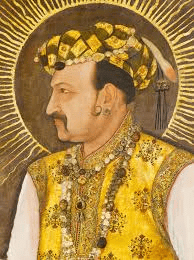 Jahangir
Jahangir
- Art and Architecture:
- Jahangir was famous for a technique called Pietra Dura , where he decorated walls with floral patterns made from semi-precious stones.
- He built the Moti Masjid in Lahore and established beautiful gardens like the Shalimar and Nishat gardens in Kashmir.
- Jahangir also introduced the use of halo lights, which were divine lights placed behind the king's head in paintings.
- Succession and Early Reign:
- After the death of Akbar, Prince Salim became king in 1605, taking the name Jahangir, meaning Conqueror of the World.
- Revolts and Political Influences:
- Jahangir faced a revolt from his son Khusrau, who was eventually defeated and imprisoned.
- Guru Arjan, the fifth Sikh Guru and a supporter of Khusrau was executed during this time.
- European Interactions:
- During Jahangir's reign, British traders visited Machilipatnam.
- Captain Hawkins and Thomas Roe also visited Jahangir's court, with Roe receiving a Farman (royal decree) to establish an English factory at Surat, which was later approved by Shah Jahan.
- Nurjahan's Influence:
- Jahangir's wife, Nurjahan, wielded significant power and influence over government affairs during his reign.
- Justice and Military Affairs:
- Jahangir set up the Zanjir-i-adal at Agra Fort, a system for people seeking royal justice. Military general Mahtab Khan revolted against Jahangir during his reign.
- Literary Contribution:
- Jahangir authored his autobiography, Tuzuk-i-Jahangiri, in Persian, detailing his life and reign.
- Military Expeditions:
- Jahangir faced significant challenges from Malik Amber during military campaigns in Ahmednagar.
- Administrative Modification:
- Jahangir introduced the du-aspah-sih-aspah system, a modification of the Mansabdari system that allowed nobles to maintain large numbers of troops without increasing their zat ranks.
Question for The Mughal Empire (1526-40) and (1555-1857)Try yourself:Who was not the Nine Jewels(Navaratna) of Akbar's Court?
View Solution
Shah Jahan (1628-1658)
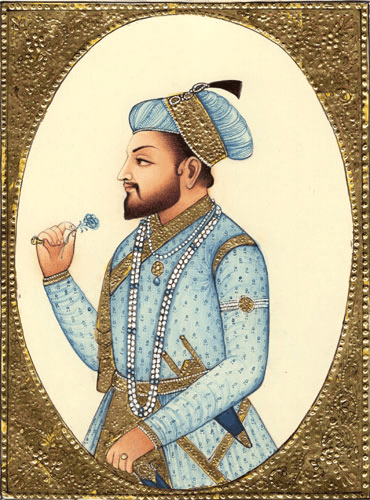 Shah Jahan
Shah Jahan
- At the time of Jahangir’s death in October 1627, Shah Jahan was in the Deccan.
- The first three years of Shah Jahan’s reign were disturbed by the rebellions of the Bundela Chief Juhar Singh and of Khan Jahan Lodi.
- In 1632, Shah Jahan expelled the Portuguese from Hugli and took control of the area.
- The Nizam Shahi Kingdom of Ahmadnagar was incorporated into the Mughal Empire during his reign.
- In 1636, Shah Jahan appointed his son Aurangzeb as the Mughal viceroy in the Deccan, dividing the territories into four subahs: Khandesh, Berar, Telangana, and Ahmadnagar.
- In 1639, Ali Mardan Khan, the Persian Governor of Kandahar, surrendered the fort to the Mughals without a fight.
- Shah Abbas II of Persia reclaimed Kandahar from the Mughals in 1649.
- The Siege of Golconda and Bijapur occurred in 1656 and 1657.
- When Shah Jahan fell ill in September 1657, his sons were in different regions: Dara in Agra, Shuja in Bengal, Aurangzeb in the Deccan, and Murad in Gujarat.
- Many foreign travellers who visited India during the reign of Shah Jahan, have left a vivid account of his reign.
- Of these two Frenchmen Bernier and Tavernier and an Italian adventurer Manucci, the author of the Storia do Mogor, are especially noteworthy.
Aurangzeb (1658 -1707)
 Aurangzeb
Aurangzeb- Aurangzeb positioned himself as the champion of Sunni orthodoxy, enforcing stricter Sharia-based policies than his predecessors.
- In 1659, he enacted several laws to reinstate the Muslim code of conduct based on the teachings of the Quran.
- He stopped the practice of inscribing the Kalima on coins and abolished the celebration of New Year’s Day (Nowruz).
- Muhtasibs were appointed in all major cities to enforce Quranic law and eliminate practices that were forbidden.
- He also ended the tradition of weighing the emperor on his birthdays and the practice of Jharokadarshan.
- In 1668, the celebration of Hindu festivals was banned.
- In 1679-1680, the Jat peasantry from Mathura revolted under the leadership of Gokala.
- In 1672, the Satnami peasants in Punjab and the Bundelas led by Champat also rose up.
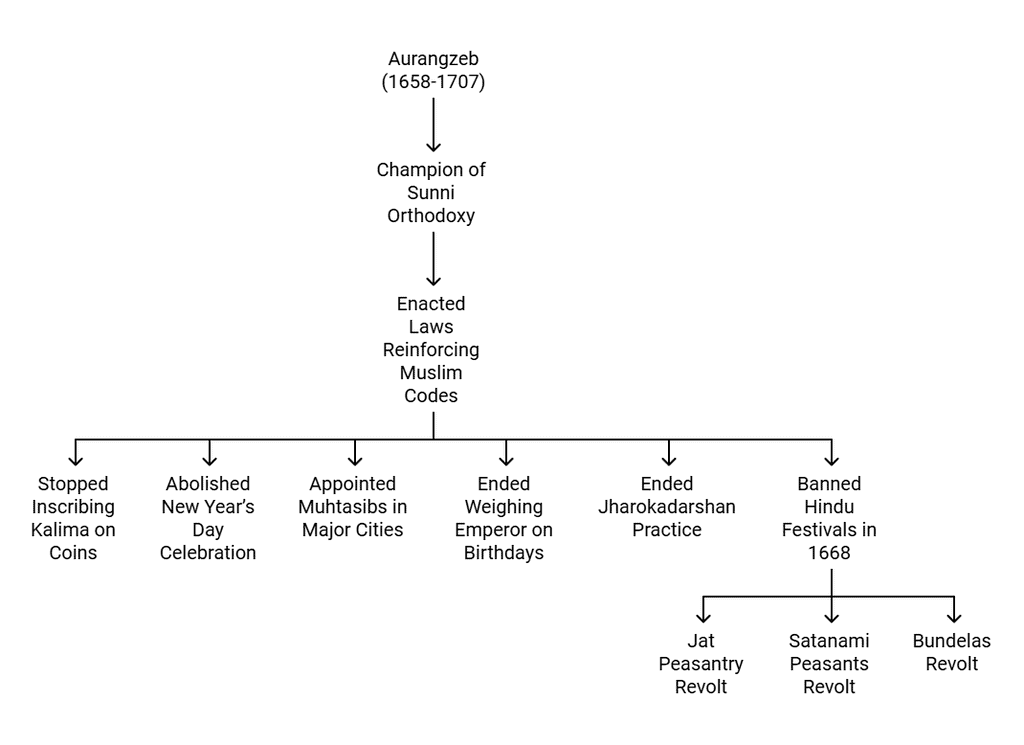
Facts To be Remembered
- Akbar's foster mother was Maham Anaga.
- Akbar successfully put down a rebellion by Uzbek nobles.
- The new capital of Rana Pratap was Chavand.
- Chandrasen, the ruler of Marwar, fought against Akbar using guerrilla tactics.
- During Akbar's reign, important texts like the Singhasan Battisi, the Atharva Veda, and the Bible were translated into Persian.
- The Kabul-Ghazni-Qandhar line was established by Akbar.
- The peasants who owned and cultivated their land were called Khudkasht.
- At the beginning of the 17th century, India's population was about 125 million.
- The Rajputs were the largest group of Hindu nobility during Akbar's rule, with the Kachhwahas being the most notable clan.
- In Aurangzeb's time, Hindus formed 33% of the nobility, with the Marathas being more than half of the Hindu nobles.
- Jahangir was known for starting the fashion of wearing expensive jewels in their ears after piercing them.
- The Chettis were a trading community from South India in Mughal India.
- The fifth Guru Arjan Das started a system of collecting offerings from the Sikh at the rate of one-tenth of their income.
- Prohibited taxes during the Mughal era were called abwabs.
- At Shah Jahan's court, Jagannath and Janardan Bhatta were famous musicians.
- Bihari Lal, a poet in Shah Jahan's time, wrote Satsai, a collection of 700 dohas and sorthas.
- An important historical work from Shah Jahan's era is the Amal-i-Salih by Mohammad Salih.
- Mirza Hossain Ali composed songs in Bengali to praise Goddess Kali.
- Amir Khusrau famously said, "If on earth be an Eden of Bliss on earth, "It is this, it is this, none but this."
Question for The Mughal Empire (1526-40) and (1555-1857)Try yourself: During Shah Jahan's reign, which territory was annexed to the Mughal Empire?View Solution
Mughal Empire at a Glance
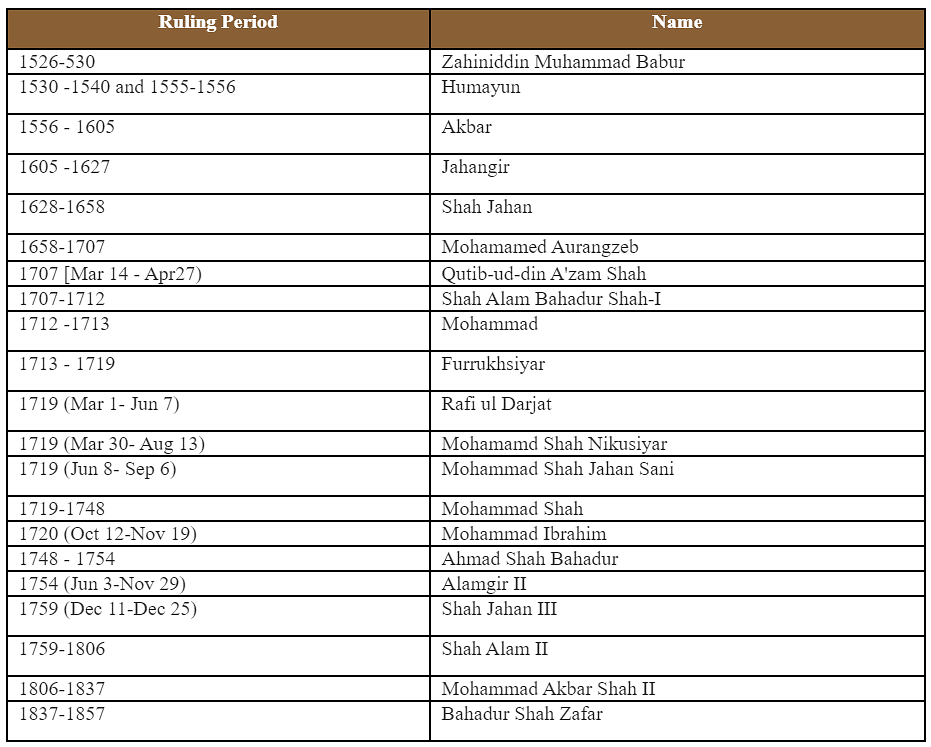
The document The Mughal Empire (1526-40) and (1555-1857) | History for UPSC CSE is a part of the UPSC Course History for UPSC CSE.
All you need of UPSC at this link: UPSC
|
110 videos|652 docs|168 tests
|
FAQs on The Mughal Empire (1526-40) and (1555-1857) - History for UPSC CSE
| 1. Mughal Samrajya ka sthal kaun se hai? |  |
Ans.Mughal Samrajya Bharat ke prachin itihas ka ek mahatvapurn hissa hai, jo 1526 se lekar 1857 tak chala. Iska sthal Bharat ke vibhinn kshetron mein tha, jismein Dilli, Agra, aur Fatehpur Sikri jaise shahron ka samavesh tha.
| 2. Babur ke samrajya ki sthal aur unki visheshata kya thi? |  |
Ans.Babur ne 1526 mein Mughal Samrajya ki sthapna ki thi. Unhone Panipat ki pehli ladai mein Ibrahim Lodi ko harakar Dilli ki gaddi par kabza kiya. Babur ek samrat ke roop mein apne shashan ko sthalit kiya, jismein unhone apne saanskrutik virasat aur shashan paddhati ko sthapit kiya.
| 3. Sher Shah Suri ka samrajya Mughal Samrajya par kaise prabhavit hua? |  |
Ans.Sher Shah Suri ne 1540 se 1545 tak shashan kiya aur unhone Mughal Samrajya ko kuch samay ke liye prabhavit kiya. Unke prashasanik sudhar aur sthal par unki nayi rajneetik vyavastha ne Mughalon ke liye mahatvapurn prerna ka kaam kiya, jisse baad mein Humayun ne apne shashan mein istemal kiya.
| 4. Jahangir aur Shah Jahan ke dauran Mughal Samrajya ka vikas kaisa tha? |  |
Ans.Jahangir (1605-1627) ke shashan mein samrajya ne kala aur saanskritik vikas dekha, jabki Shah Jahan (1628-1658) ne Taj Mahal jaise pramukh samarak bana kar isse aur bhi vikasit kiya. Dono samraton ne apne samrajya ko sanrakshit karne aur vyavastha ko majboot karne mein mahatvapurn bhumika nibhayi.
| 5. Mughal Samrajya ka patan kab aur kyun hua? |  |
Ans.Mughal Samrajya ka patan 1857 ki Vidrohi ke baad hua. Is samay, antarraashtreey rajneetik paristithiyon, samrajya mein aarthik sankat, aur vishesh roop se angrezi colonial Vasiyat ke prabhav se Mughal Samrajya ki shakti dhirhe-dhirhe kam hoti gayi, jisse uska patan hua.
Related Searches

















